11
The passive NPN output will function on battery power, however this will reduce the battery
life of the instrument by approximately 50%. For applications requiring an alarm output which
is not triggered often the effect on battery life is expected to be negligible.
Internal protection is provided for voltage spikes caused by switching inductive loads (relays,
solenoids, etc.) by fitment of an internal flyback (suppressor) diode to the passive NPN output.
No additional circuit components are required when triggering a DC relay or DC solenoid with
this output.
2.3.10 Isolated Digital Output
The Isolated digital output is provided by means of an Opto-Coupler, which provides a signal
with no electrical connections to the other internal circuitry of the instrument. The isolated
output should be used preferentially whenever a user requires both an analogue output and a
digital output (alarm or pulse signal) to a common receiving instrument; this will avoid the
creation of ground loops which interrupt the analogue signal. The isolated digital output is also
chosen whenever a PNP signal is required; the configuration of PNP vs. NPN is accomplished
via wiring which can be seen in the electrical installation section of this manual (section 4.3).
The isolated digital output is rated to 50V AC or DC, and 300mA; so should be used instead of
the passive NPN output for switching any loads greater than 30VDC or for switching any low
voltage AC loads <50VAC. The isolated digital output is not internally protected from voltage
spikes generated by inductive loads such as relays or solenoids, so a diode (1N004
recommended) should be fitted across any inductive DC loads as shown in section 4.3.5. For AC
relays or solenoids voltage spike protection should be provided by fitment of a metal oxide
varistor fitted in place of the diode (EPCOS SIOV-S05K50 or SIOV-S07K50 recommended).
Where the recommended diode or varistor is not available, a similar component of equivalent
specification may be used.
2.3.11 Battery Power
The instrument is powered by a Lithium Thionyl Chloride (Li/SOCl2) AA size battery which is
non-rechargeable. When operating under average conditions the instrument is expected to
have approximately 5 years of battery life; average conditions are considered to be a reed
switch input from a Flomec flowmeter with no outputs used. High input frequencies (~1kHz
and higher) from a turbine flowmeter will reduce battery life by around 20%, and operation of
a battery powered scaled pulse output will reduce battery life by approximately 50%. When
the NPN transistor is used for an alarm with infrequent operation the reduction of battery life
may be negligible.

